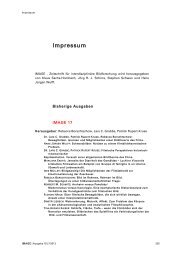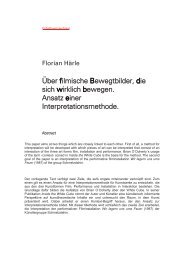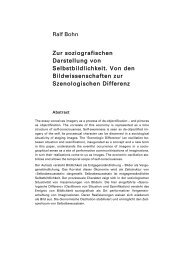Image 9 - Gesellschaft für interdisziplinäre Bildwissenschaft
Image 9 - Gesellschaft für interdisziplinäre Bildwissenschaft
Image 9 - Gesellschaft für interdisziplinäre Bildwissenschaft
Sie wollen auch ein ePaper? Erhöhen Sie die Reichweite Ihrer Titel.
YUMPU macht aus Druck-PDFs automatisch weboptimierte ePaper, die Google liebt.
DIETER MAURER/ CLAUDIA RIBONI/ BIRUTE GUJER: PICTURE GENESIS AND PICTURE CONCEPT<br />
not just the various possibilities within a sphere of production and expression, but also all these<br />
spheres.<br />
However, on the basis of all these arguments, the present approach to understanding pictures<br />
as signs should not be attributed to a single party in the current positional dispute, above all in<br />
the ›<strong>Bildwissenschaft</strong>‹ dispute. The starting point here is not a view of signs and representation<br />
deduced from verbal language. Different kinds of signs refer to different kinds of cognition, and,<br />
thus, counting pictures as signs does not mean seeing them as phenomena that are very close to<br />
words in every case.<br />
Sixthly – Picture are not necessarily and in all their aspects subject to convention.<br />
Observing the universality of early picture genesis, with regard both to so-called ›abstract‹ and to<br />
analogous aspects, demands that the picture be understood as such.<br />
Observing the universality of an important part of the genesis of early graphic structure requires<br />
critical examination of the characterization of pictorial representation, as stated by Goodman<br />
(1976). The same holds true for Eco’s concept (Eco 1972), structuring the visual code in terms of<br />
›iconic figures‹, ›iconic signs‹ and ›iconic semes‹.<br />
To avoid misunderstandings: empirically establishing a universal aspect of picture genesis, and<br />
consequently rejecting a fundamental cultural coding of all pictures in all their aspects does not<br />
mean insisting on an ahistorical and socio-biological perspective (both adjectives are borrowed<br />
from Mitchell; see Mitchell 1986: 37) and saying that pictures are natural because they are not<br />
coded. Referring to the universal aspect of picture genesis means reopening the question of how<br />
to understand quasi-equal picture qualities for different cultural contexts.<br />
Seventhly – pictures are not necessarily and in all their aspects subject to communication between<br />
two or more people.<br />
Observing the universality of early picture genesis again demands understanding the picture as<br />
such: a structure with universal character excludes any concrete communication by that very fact.<br />
Observations made in investigating the early graphic process, as well as the above-mentioned<br />
findings about early analogy formation that adults understand only when children comment on<br />
them verbally in their term confirm partial autonomy of the picture from concrete communication<br />
between two people.<br />
3. The ›concrete‹ as sign<br />
The above theses express demands on a general concept of the picture which are to be deduced<br />
from the perspective of early picture genesis.<br />
IMAGE I Ausgabe 9 I 1/2009 38



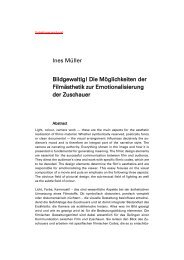
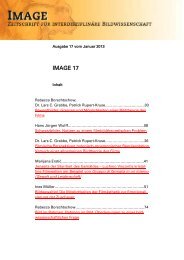
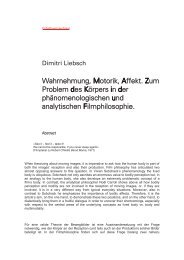
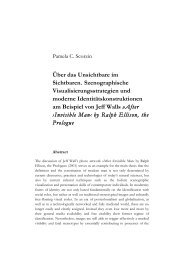
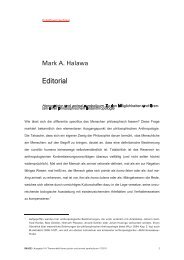
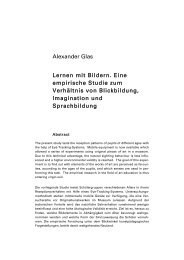

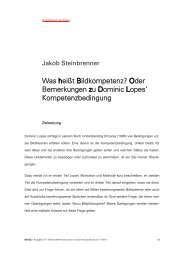
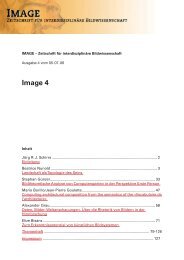
![image 11 [pdf] - Gesellschaft für interdisziplinäre Bildwissenschaft](https://img.yumpu.com/41525154/1/184x260/image-11-pdf-gesellschaft-fur-interdisziplinare-bildwissenschaft.jpg?quality=85)
